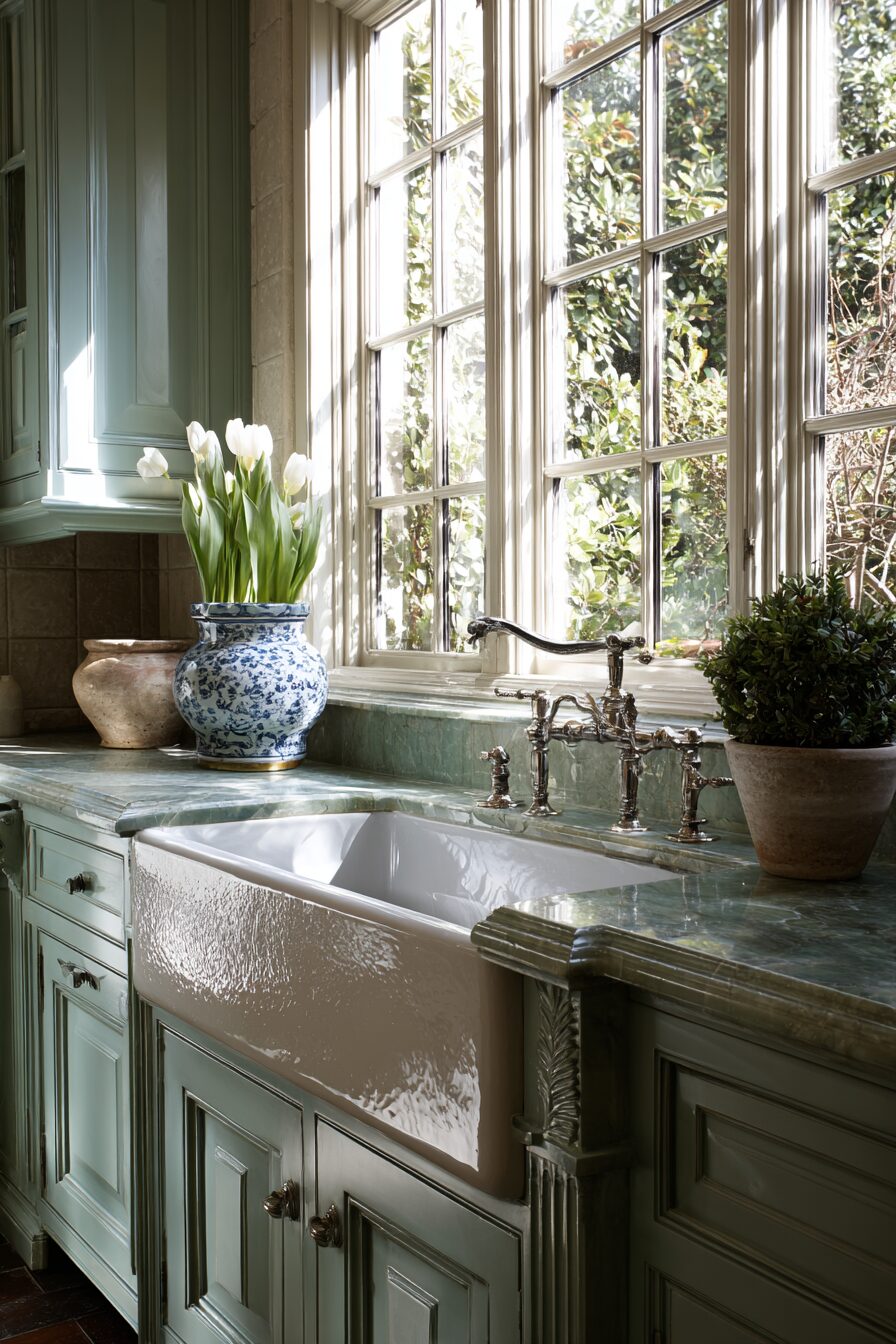French chateau kitchens represent the perfect blend of old-world elegance and timeless functionality.
These spaces capture the romantic essence of French countryside living while maintaining the sophistication of aristocratic design.
If you’re renovating your entire kitchen or simply adding French-inspired touches, these ideas will help you create a space that feels both luxurious and warmly inviting.
Embrace the Timeless Beauty of Limestone Countertops and Backsplashes
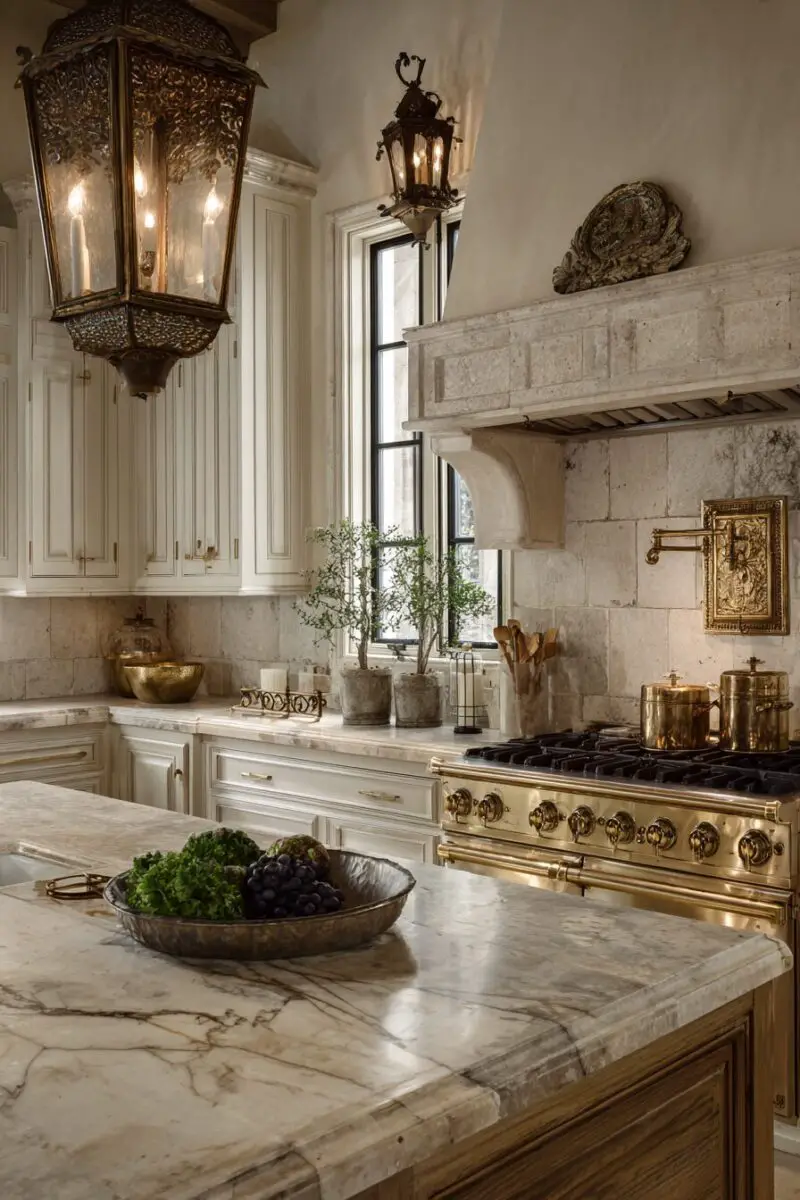
Your kitchen countertops can instantly transport you to the Loire Valley with the addition of creamy limestone surfaces.
Limestone offers an authentic French chateau aesthetic that synthetic materials simply cannot replicate.
The natural variations in color and texture create visual interest while maintaining the sophisticated neutrality that French design is famous for.
You’ll find that limestone develops a beautiful patina over time, becoming even more gorgeous with age and use.
The soft, matte finish of limestone countertops provides a stunning contrast to polished fixtures and creates a sense of understated luxury.
French chateaus traditionally featured limestone quarried from local sources, giving each kitchen a unique character that reflected its regional heritage.
Your limestone backsplash can extend from counter to ceiling, creating a seamless wall treatment that makes the space feel grand and cohesive.
The natural porosity of limestone requires proper sealing, but this maintenance ritual becomes part of the authentic French kitchen experience.
You can choose from various limestone finishes, including honed, tumbled, or naturally split surfaces, each offering different levels of texture and visual appeal.
Pair your limestone surfaces with warm brass or copper fixtures to enhance the authentic French countryside feeling.
The neutral tones of limestone work beautifully with both warm and cool color palettes, making it an versatile choice for any French-inspired design scheme.
You’ll appreciate how limestone naturally complements other authentic French materials like aged wood, wrought iron, and natural stone flooring.
The thermal properties of limestone help maintain consistent temperatures, making it practical for both food preparation and the overall comfort of your kitchen space.
French chateau kitchens often featured limestone work surfaces that were both functional and beautiful, serving multiple generations of families who appreciated quality craftsmanship.
Your investment in limestone countertops and backsplashes will create a foundation for authentic French style that will remain timeless and elegant for decades to come.
Display Vintage Copper Cookware Like Precious Artworks
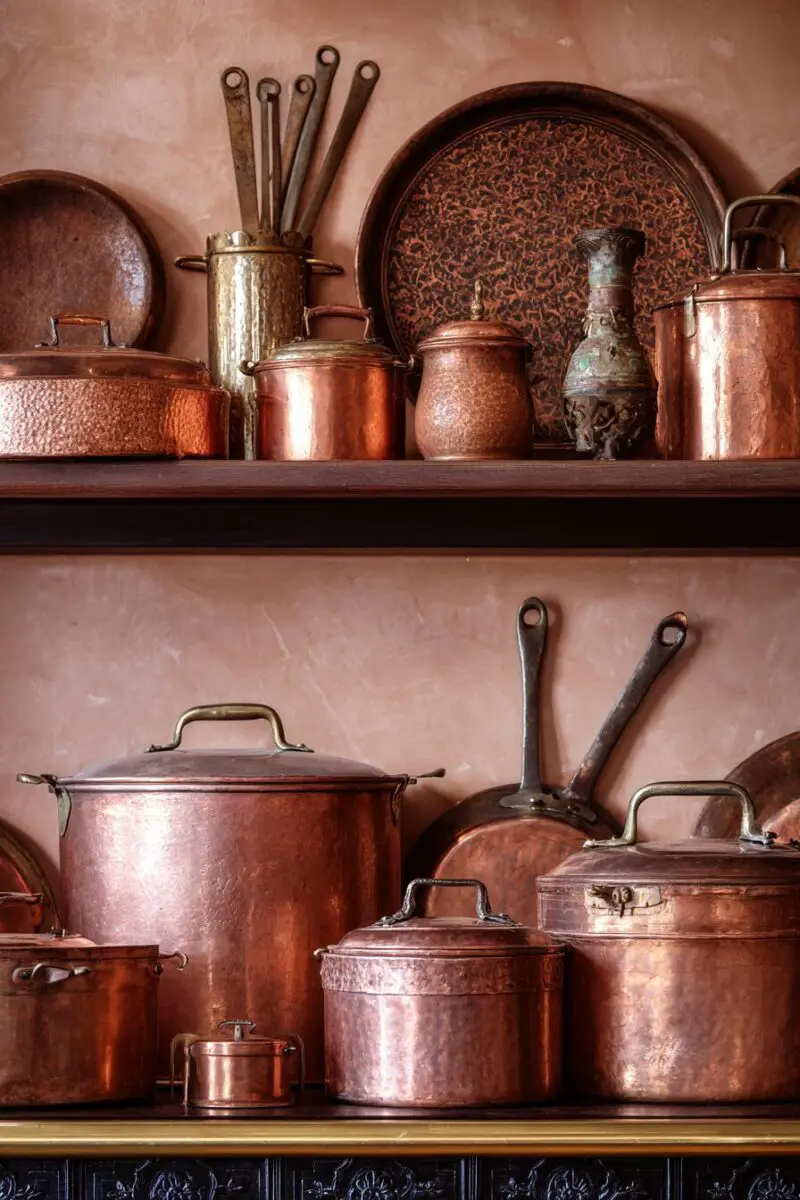
Your walls deserve the warm, gleaming beauty of authentic French copper cookware hanging like treasured paintings.
Copper pots and pans were the hallmark of serious French cooking, prized for their superior heat conductivity and professional-grade performance.
You can create stunning visual displays by hanging copper pieces on wrought iron pot racks or mounting them directly on exposed brick or stone walls.
The rich, burnished glow of well-seasoned copper adds instant warmth and authenticity to any kitchen space.
French chefs have relied on copper cookware for centuries, understanding that its unique properties allow for precise temperature control and even heat distribution.
Your collection can include traditional French pieces like copper saucepans, stockpots, and the iconic French copper tarte tatin pans.
The patina that develops on copper over time tells the story of countless delicious meals and adds to its authentic charm.
You’ll find that antique copper pieces often feature brass handles and decorative elements that enhance their visual appeal and historical significance.
Proper care of copper cookware becomes a meditative ritual that connects you to generations of French cooks who treasured these same tools.
The reflective quality of copper surfaces helps bounce light around your kitchen, creating a warm, inviting atmosphere reminiscent of French country homes.
You can source authentic vintage pieces from antique markets, estate sales, or specialty shops that import genuine French cookware.
Professional-quality copper cookware represents both form and function, serving as beautiful decoration when not in active use for cooking.
The investment in quality copper pieces pays dividends in both cooking performance and aesthetic appeal, lasting for generations with proper care.
French chateau kitchens traditionally showcased their finest cookware as symbols of culinary expertise and household prosperity.
Your copper collection becomes a conversation starter, allowing you to share the rich history and superior craftsmanship behind each carefully chosen piece.
Design Your Dream Room in Minutes!
🏡 Start Creating FREE →Create Stunning French Country Cabinetry with Glass-Front Doors
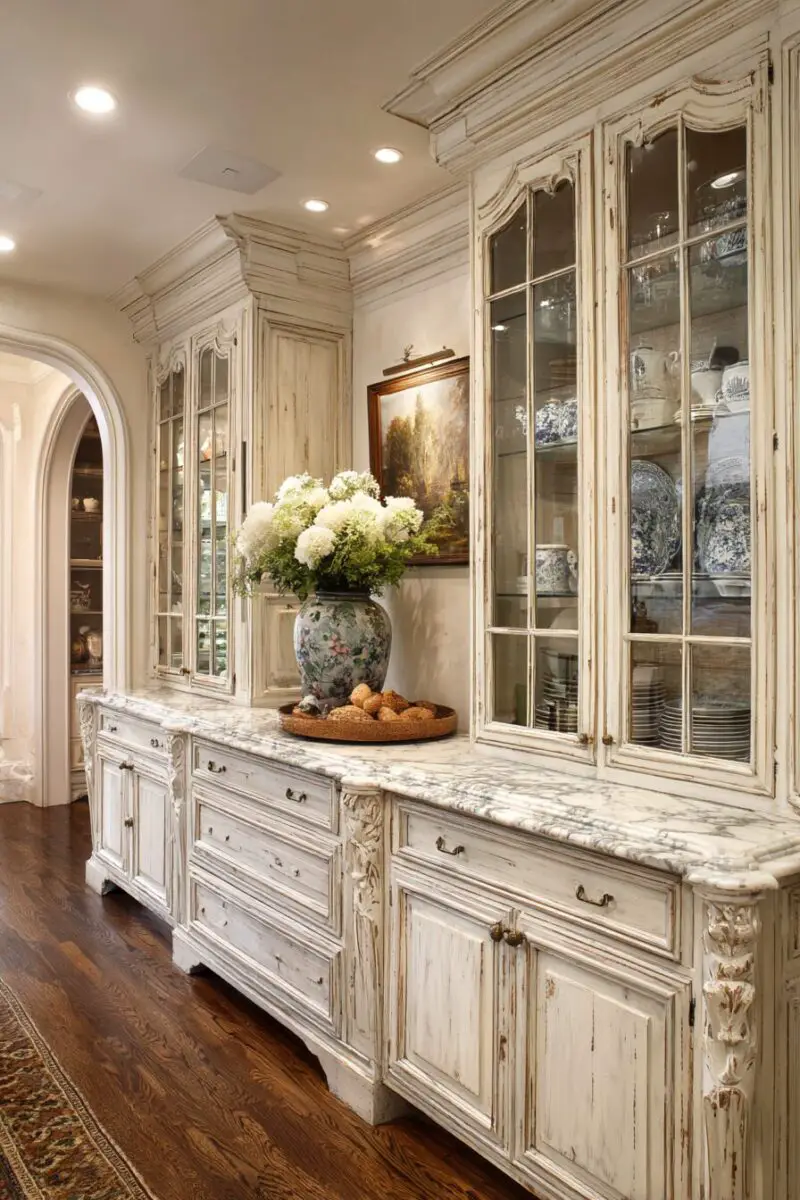
Your kitchen storage becomes a beautiful display opportunity with glass-front cabinet doors that showcase your finest dishes and serving pieces.
Glass-front cabinetry allows you to create museum-quality displays of beautiful china, crystal stemware, and artisanal pottery while keeping items easily accessible.
The transparency of glass doors makes your kitchen feel more open and spacious while maintaining the organized storage that modern life demands.
You can choose from various glass types, including clear, seeded, or lightly frosted options that provide different levels of visibility and privacy.
French country cabinetry traditionally featured simple, clean lines with subtle decorative details that emphasized craftsmanship over ornamentation.
Your cabinet frames can be painted in classic French colors like soft sage green, warm cream, or traditional French blue for authentic period appeal.
The contrast between solid lower cabinets and glass-front upper cabinets creates visual balance while providing both concealed and display storage options.
You’ll find that glass-front doors encourage you to maintain beautifully organized cabinet interiors, turning storage into part of your kitchen’s decorative scheme.
Interior cabinet lighting enhances the display quality of glass-front doors, creating warm, inviting glows that highlight your cherished collections.
The reflective quality of glass surfaces helps bounce light around your kitchen, making the space feel brighter and more open.
You can incorporate chicken wire or decorative metal grilles behind the glass for added texture and authentic French farmhouse appeal.
Traditional French cabinetry often featured hand-forged hardware in brass or wrought iron that complemented the rustic yet refined aesthetic.
Your glass-front cabinets provide the perfect opportunity to display collections of French pottery, vintage glassware, or beautiful serving pieces.
The maintenance of glass-front doors becomes easier when you choose high-quality tempered glass that resists fingerprints and cleaning challenges.
Your investment in quality glass-front cabinetry creates a sophisticated storage solution that combines French elegance with modern functionality.
TRENDING NOW
13 Eye-Catching Fridge Decor Ideas That WowInstall an Authentic Farmhouse Sink with Period-Appropriate Fixtures
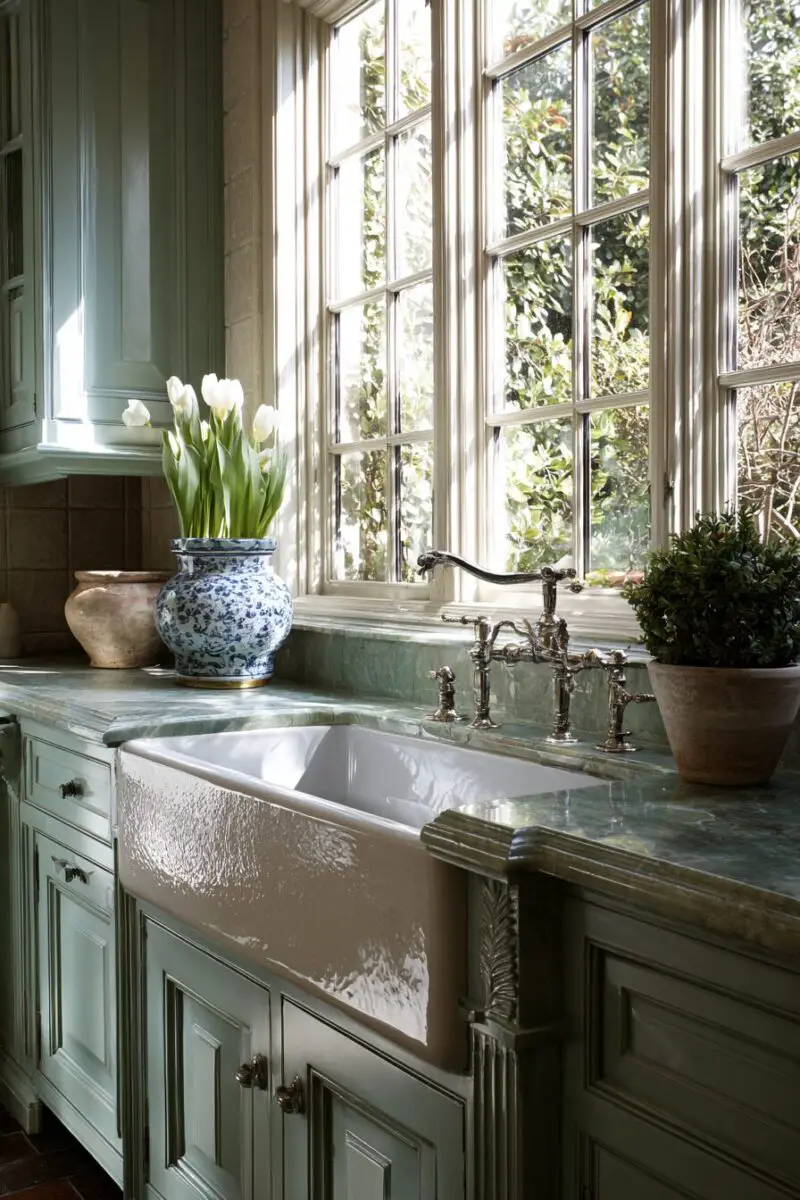
Your kitchen gains instant French countryside charm with a deep, wide farmhouse sink that becomes the hardworking centerpiece of your culinary space.
Farmhouse sinks, also known as apron-front sinks, were essential features in French country kitchens where large families required substantial washing and food preparation capabilities.
The generous size and front-facing design of farmhouse sinks make them perfect for washing large pots, preparing vegetables, and handling the demands of serious cooking.
You can choose from traditional materials like fireclay, cast iron, or natural stone, each offering different benefits and authentic period appeal.
The exposed front panel of a farmhouse sink creates a beautiful focal point that anchors your kitchen design and establishes its French country character.
Your sink installation requires careful planning since farmhouse sinks are heavier and larger than standard drop-in models, often requiring cabinet modifications.
Traditional French farmhouse sinks were often positioned beneath windows to provide natural light for kitchen tasks while offering views of gardens and courtyards.
You’ll appreciate the ergonomic benefits of farmhouse sinks, which reduce back strain by allowing you to stand closer to the basin during washing tasks.
The deep basin of a farmhouse sink accommodates oversized cookware and makes cleaning large serving platters and roasting pans much more manageable.
Period-appropriate fixtures should complement your farmhouse sink with designs that reflect traditional French sensibilities and quality craftsmanship.
You can choose from brass, copper, or brushed nickel finishes that develop beautiful patinas over time and resist the wear of daily use.
Traditional French faucets often featured separate hot and cold taps, but modern interpretations can provide contemporary convenience while maintaining period aesthetics.
Your farmhouse sink becomes a conversation piece that guests immediately notice and appreciate for its authentic charm and practical functionality.
The investment in a quality farmhouse sink and appropriate fixtures creates a durable, beautiful foundation that will serve your kitchen for decades.
Your authentic farmhouse sink installation connects your modern kitchen to centuries of French culinary tradition and countryside living.
Add Dramatic Wrought Iron Pot Racks and Light Fixtures
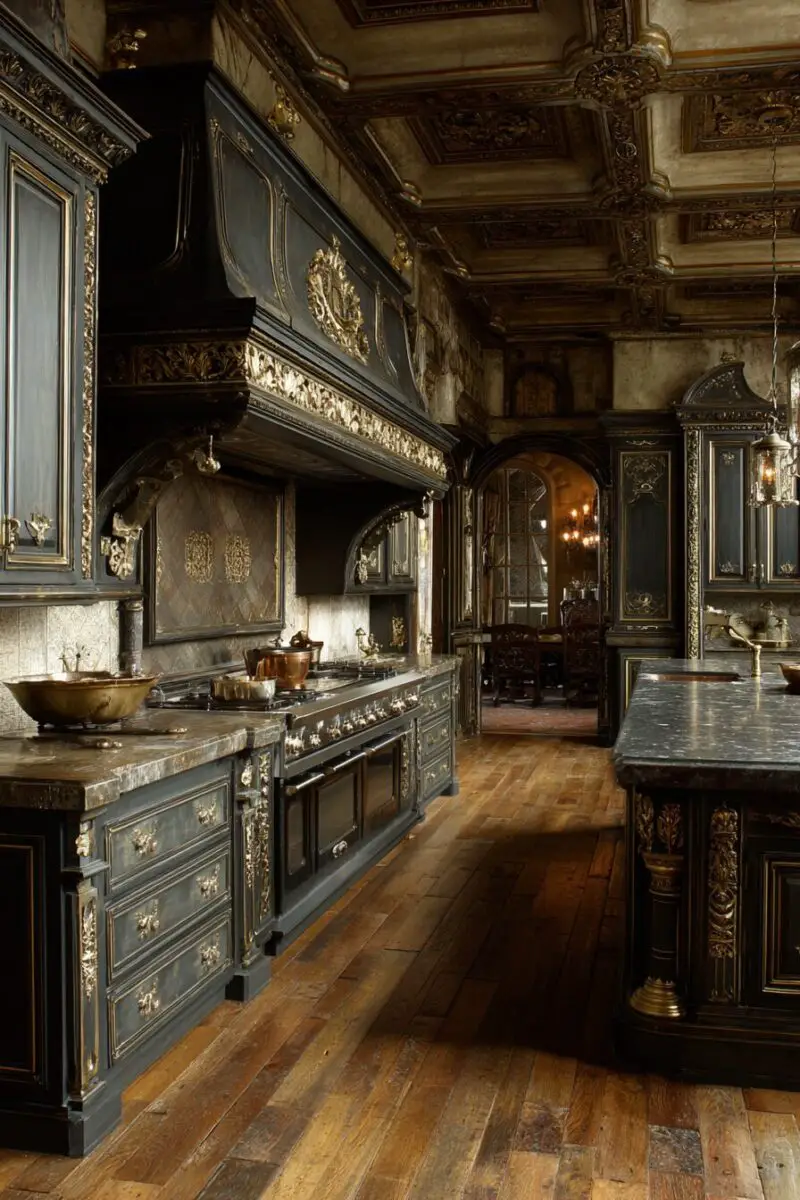
Your kitchen ceiling becomes a gallery of functional art with authentic wrought iron pot racks that showcase your cookware while freeing up valuable cabinet space.
Wrought iron represents the pinnacle of French metalworking craftsmanship, featuring hand-forged details that machine production cannot replicate.
The dark, matte finish of traditional wrought iron provides stunning contrast against light-colored walls and ceilings while adding masculine strength to feminine French design elements.
You can hang your finest copper pots, cast iron skillets, and stainless steel cookware from sturdy wrought iron hooks that are both beautiful and supremely functional.
French blacksmiths traditionally created unique pot rack designs that reflected regional styles and individual artistic expression, making each piece one-of-a-kind.
Your wrought iron lighting fixtures can include chandeliers, pendant lights, and sconces that feature authentic details like twisted metal, decorative scrollwork, and candle-style bulbs.
The handcrafted quality of wrought iron creates subtle imperfections and variations that add character and authenticity to your French chateau kitchen design.
You’ll find that wrought iron’s durability makes it perfect for kitchen environments where moisture, heat, and daily use demand robust materials.
The installation of overhead pot racks requires proper ceiling support, but the freed cabinet space and dramatic visual impact make the effort worthwhile.
Wrought iron develops a natural patina over time that enhances its rustic appeal and connects your kitchen to the aging process that gives French chateaus their charm.
You can combine pot racks with herb drying capabilities, creating dual-purpose installations that serve both storage and food preservation functions.
The scale and presence of wrought iron fixtures help establish the grand proportions associated with French chateau architecture and design.
Your wrought iron elements should be professionally installed to ensure safety and proper support for both decorative and functional loads.
Traditional French wrought iron often incorporated nature-inspired motifs like grape vines, wheat stalks, and floral elements that celebrated the connection between kitchen and garden.
Your investment in authentic wrought iron pieces creates lasting beauty that improves with age and connects your kitchen to centuries of French metalworking tradition.
TRENDING NOW
13 Luxurious Black and Gold Kitchen DesignsChoose Natural Stone Flooring for Authentic Character
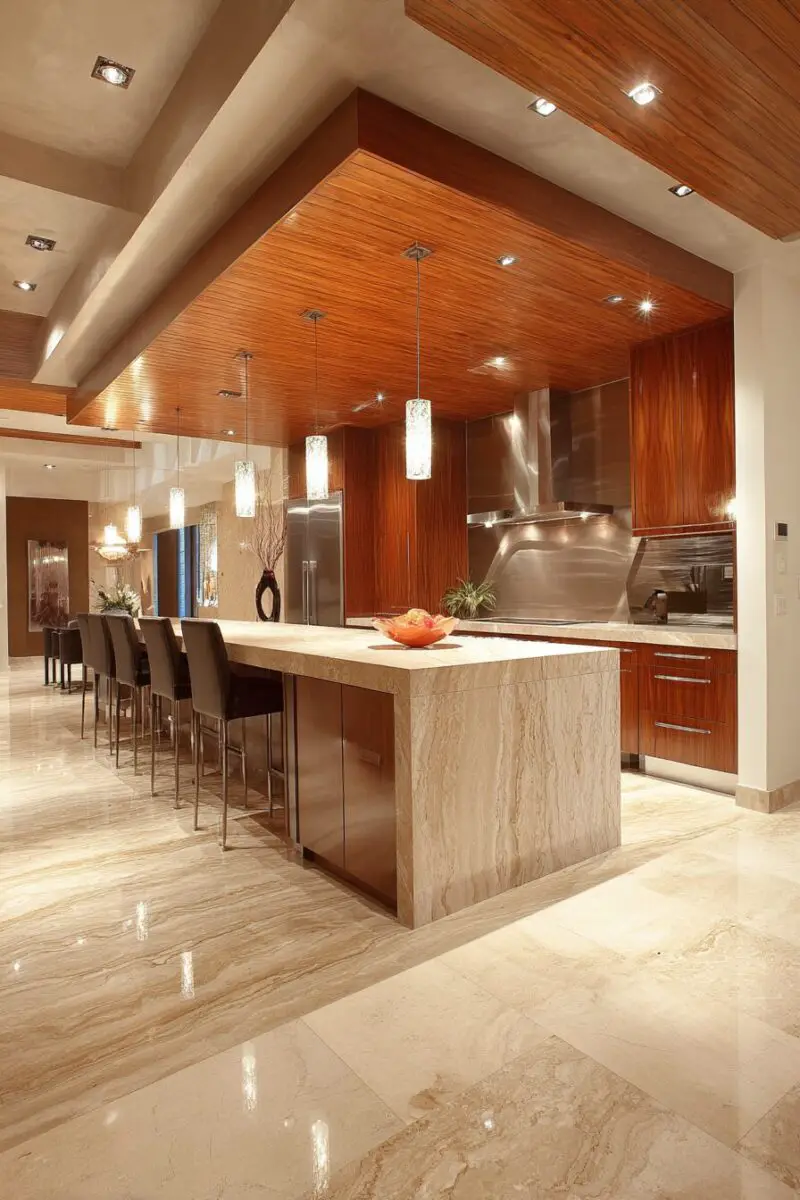
Your kitchen foundation sets the tone for authentic French chateau style with natural stone flooring that has weathered centuries in European castles and country homes.
Stone flooring provides the perfect combination of durability, beauty, and historical authenticity that synthetic materials simply cannot match.
The cool temperature of stone floors feels refreshing underfoot during warm cooking sessions and provides natural temperature regulation throughout the seasons.
You can select from limestone, travertine, slate, or reclaimed stones, each offering unique colors, textures, and historical connections to French architecture.
French chateaus traditionally featured locally quarried stone that reflected the geological character of their specific regions, creating unique regional styles.
Your stone installation can incorporate traditional patterns like random ashlar, running bond, or versailles patterns that add visual interest and movement.
The natural variations in stone create subtle color differences and unique markings that tell the geological story of millions of years of natural formation.
You’ll appreciate how stone floors develop beautiful patinas over time, becoming more lustrous and characterful with proper care and regular use.
The thermal mass of stone flooring helps moderate kitchen temperatures, staying cool in summer and retaining warmth from radiant heating systems in winter.
Proper sealing protects your stone investment while maintaining the natural beauty and slip-resistance that makes stone practical for kitchen environments.
You can enhance the authentic appeal by choosing tumbled or naturally split stone surfaces that show tool marks and weathering consistent with historical installations.
The substantial weight and thickness of natural stone creates a sense of permanence and quality that elevates your entire kitchen design.
Your stone flooring provides the perfect neutral foundation that complements warm wood tones, gleaming metals, and soft fabric textures throughout your French-inspired space.
Professional installation ensures proper substrate preparation, leveling, and sealing that protects your investment and maximizes the longevity of your stone floors.
Your natural stone flooring creates an immediate connection to French architectural heritage while providing a practical, beautiful surface that will serve generations.
TRENDING NOW
13 Dark Academia Kitchens That Exude EleganceEmbrace Traditional French Provincial Color Palettes
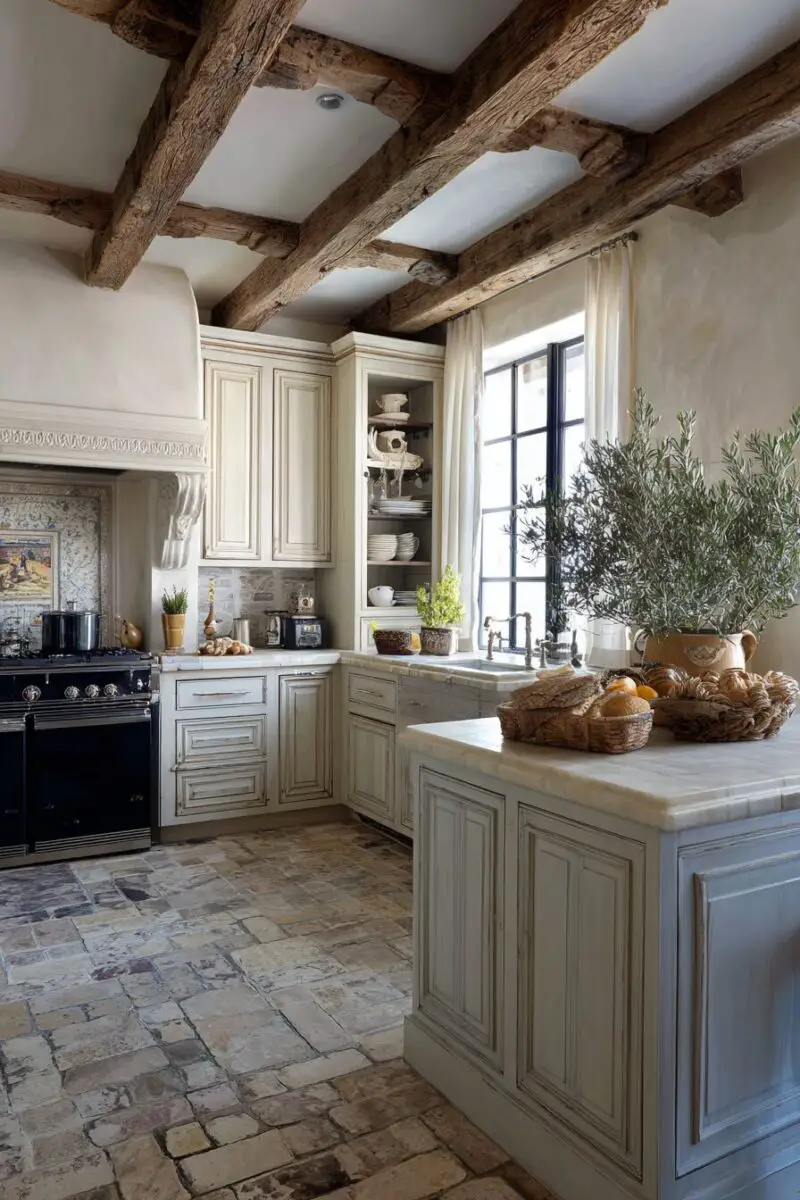
Your kitchen transforms into a French countryside retreat with carefully chosen colors that reflect the soft, natural palette found in traditional Provençal homes.
French provincial colors draw inspiration from the natural landscape, featuring warm earth tones, soft blues, gentle greens, and creamy whites that create serene, welcoming environments.
The sophisticated restraint of French color choices creates timeless appeal that avoids trendy schemes in favor of enduring beauty and elegance.
You can anchor your palette with warm cream or soft white walls that provide the perfect backdrop for colorful accessories and natural materials.
Traditional French kitchens often featured soft sage green cabinetry that reflected the olive groves and herb gardens surrounding country homes.
Your color scheme can incorporate the gentle blue-gray of French lavender fields, bringing calming sophistication to your kitchen design.
The warm ochre and sienna tones found in French earth pigments add richness and depth while maintaining the understated elegance characteristic of French design.
You’ll find that French provincial colors work beautifully with natural materials like aged wood, natural stone, and weathered metals that develop beautiful patinas.
The subtle variations within each color family create visual interest without overwhelming the space or competing with architectural details and fine craftsmanship.
Professional color consultation can help you achieve the perfect balance of warm and cool tones that creates the sophisticated harmony found in authentic French interiors.
You can introduce color through painted cabinetry, decorative tiles, fabric accents, and carefully chosen accessories that can be easily updated over time.
The psychological impact of French provincial colors creates a sense of calm and serenity that makes your kitchen a peaceful retreat from busy modern life.
Your color choices should reflect the changing light throughout the day, appearing warm and inviting in morning sun and elegant and sophisticated in evening lamplight.
Traditional French homes often featured subtle color variations throughout different rooms, creating gentle transitions that felt natural and unforced.
Your commitment to authentic French provincial colors creates a cohesive design foundation that will remain beautiful and relevant for decades to come.
TRENDING NOW
13 Sage Green Cabinet Designs You'll LoveIncorporate Antique French Furniture Pieces
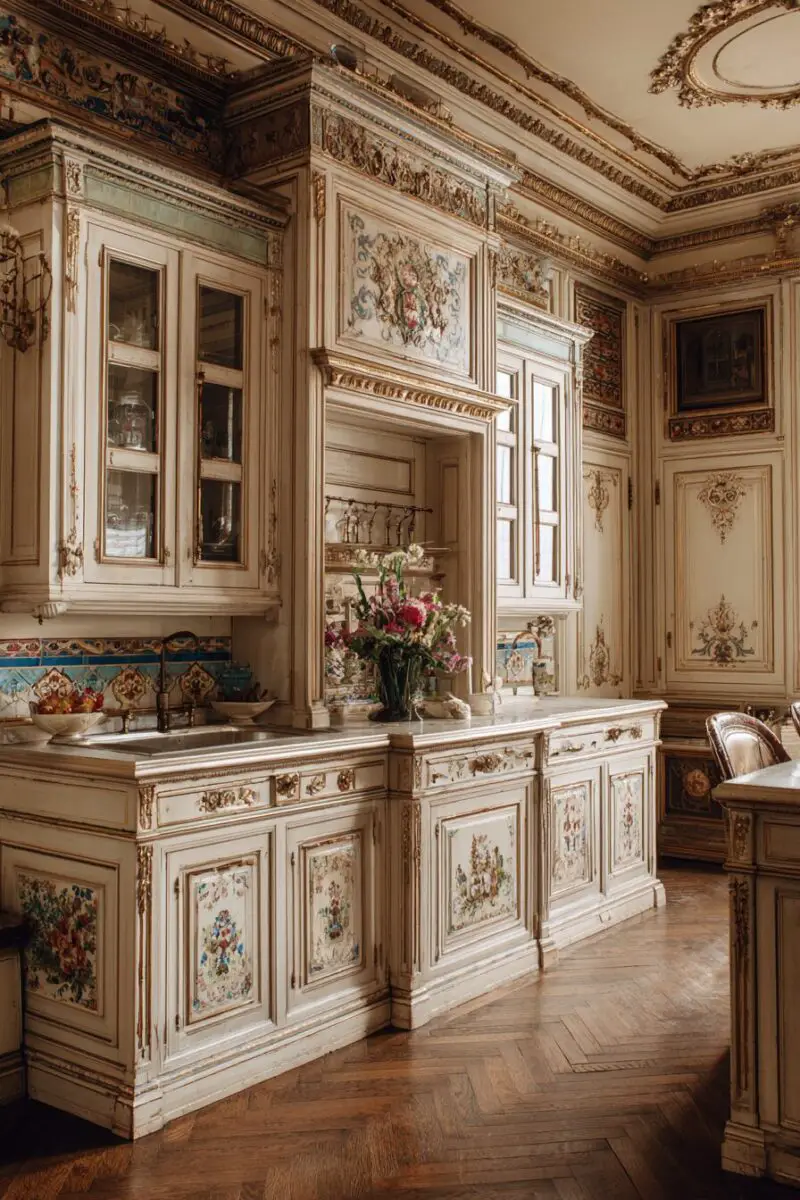
Your kitchen gains instant authenticity with carefully chosen antique French furniture pieces that serve both functional and decorative purposes in your culinary space.
Antique French furniture brings centuries of history, craftsmanship, and patina that cannot be replicated by contemporary reproductions or mass-produced pieces.
The rich wood tones, hand-carved details, and time-worn finishes of authentic French pieces add layers of visual interest and textural complexity.
You can incorporate a French farmhouse table as a kitchen island, providing both workspace and a conversation-worthy centerpiece that anchors your design.
Traditional French armoires can be repurposed as pantry storage, offering concealed organization behind beautiful carved doors that hide modern necessities.
Your antique pieces should show honest wear and aging that tells the story of generations of French families who treasured these functional works of art.
The scale and proportions of French antiques often exceed modern furniture dimensions, creating the grand presence associated with chateau living.
You’ll find that antique French chairs, benches, and stools provide both seating and sculptural elements that enhance your kitchen’s authentic character.
The investment in quality antique pieces often proves more economical than purchasing high-end reproductions while providing infinitely more character and authenticity.
Professional restoration can address structural issues while preserving the original finishes and patina that give antique furniture its distinctive charm.
You can source authentic pieces from estate sales, antique dealers, or specialty importers who understand the difference between genuine French antiques and later reproductions.
The mixing of different periods and styles within French antiques creates the layered, collected-over-time appearance that characterizes genuine French interiors.
Your antique furniture should complement rather than overwhelm your kitchen’s primary functions, enhancing usability while adding beauty and historical connection.
Traditional French furniture construction techniques used mortise and tenon joinery, hand-forged hardware, and time-tested finishes that ensure longevity and continued beauty.
Your antique French furniture pieces become family heirlooms that connect your modern kitchen to centuries of French domestic life and craftsmanship traditions.
Cultivate Fresh Herbs and Natural Elements
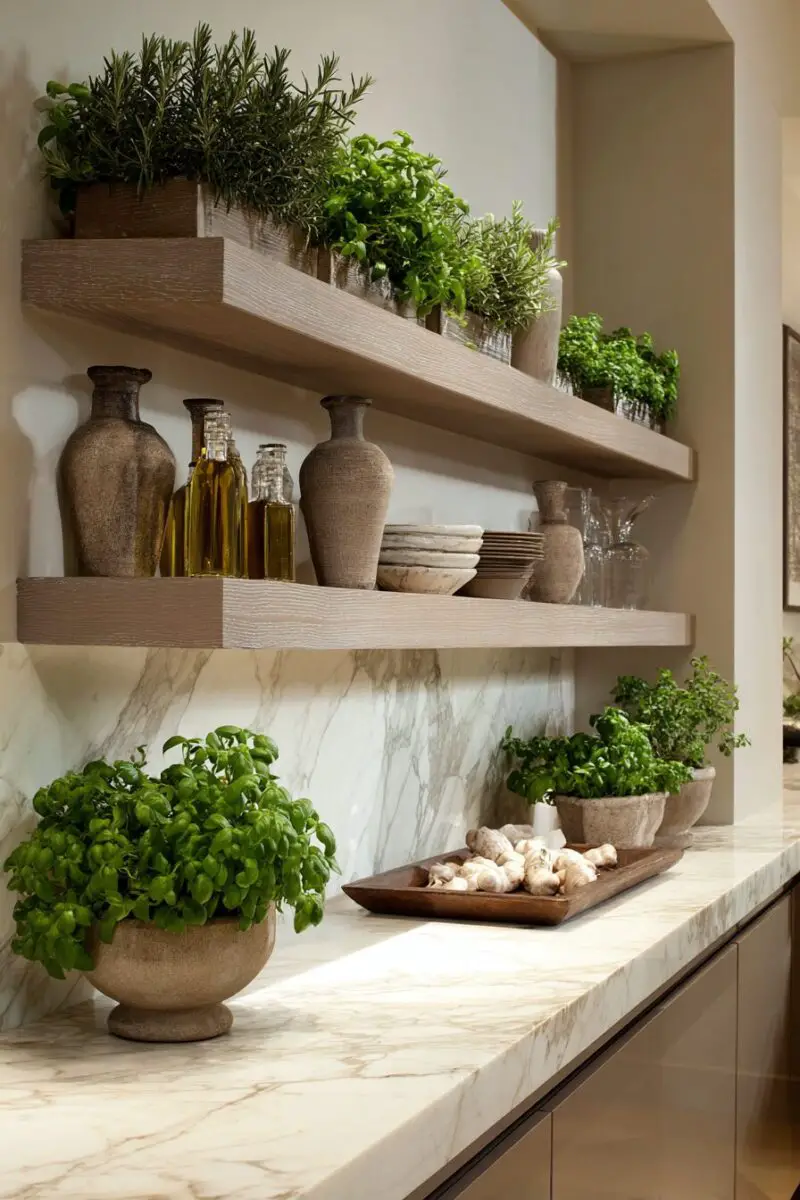
Your French chateau kitchen comes alive with the addition of fresh herb gardens and natural elements that connect your cooking space to the bounty of French countryside gardens.
Growing fresh herbs indoors creates an immediate sensory connection to traditional French cooking, where herbs like thyme, rosemary, and lavender played essential roles in daily cuisine.
The fragrance of fresh herbs fills your kitchen with natural aromatics that enhance both the cooking experience and the overall ambiance of your space.
You can create windowsill herb gardens using traditional French pottery or galvanized metal containers that complement your rustic design aesthetic.
French kitchen gardens traditionally featured both culinary and medicinal herbs, reflecting the practical approach to living that characterized French country life.
Your herb cultivation can include classic French varieties like tarragon, chervil, and fine herbs that elevate your cooking while providing authentic flavors.
The daily ritual of watering, pruning, and harvesting herbs creates a mindful connection to seasonal rhythms and natural cycles.
You’ll find that fresh herbs improve dramatically over their dried counterparts, providing bright, complex flavors that enhance simple French country dishes.
Natural elements like fresh flowers, seasonal fruits, and rustic baskets add organic textures and colors that soften the hard surfaces of kitchen equipment.
The integration of living plants requires attention to light exposure, drainage, and air circulation to ensure healthy growth and beautiful displays.
You can extend your herb garden to include hanging bundles of drying herbs that serve both functional and decorative purposes throughout your kitchen.
The changing seasons provide opportunities to rotate your natural displays, bringing pussy willows in spring, sunflowers in summer, and dried seed pods in autumn.
Your commitment to fresh, natural elements reflects the French appreciation for quality ingredients and the connection between garden and table.
Traditional French homes featured kitchen gardens just outside the cooking space, creating easy access to fresh ingredients throughout the growing season.
Your integration of fresh herbs and natural elements creates a living, breathing kitchen environment that celebrates the French art of combining beauty with functionality.
These French chateau kitchen ideas will help you create a space that feels both authentic and livable.
Remember that the best French-inspired kitchens develop slowly over time, with each carefully chosen element contributing to an overall sense of timeless elegance and comfortable sophistication.

